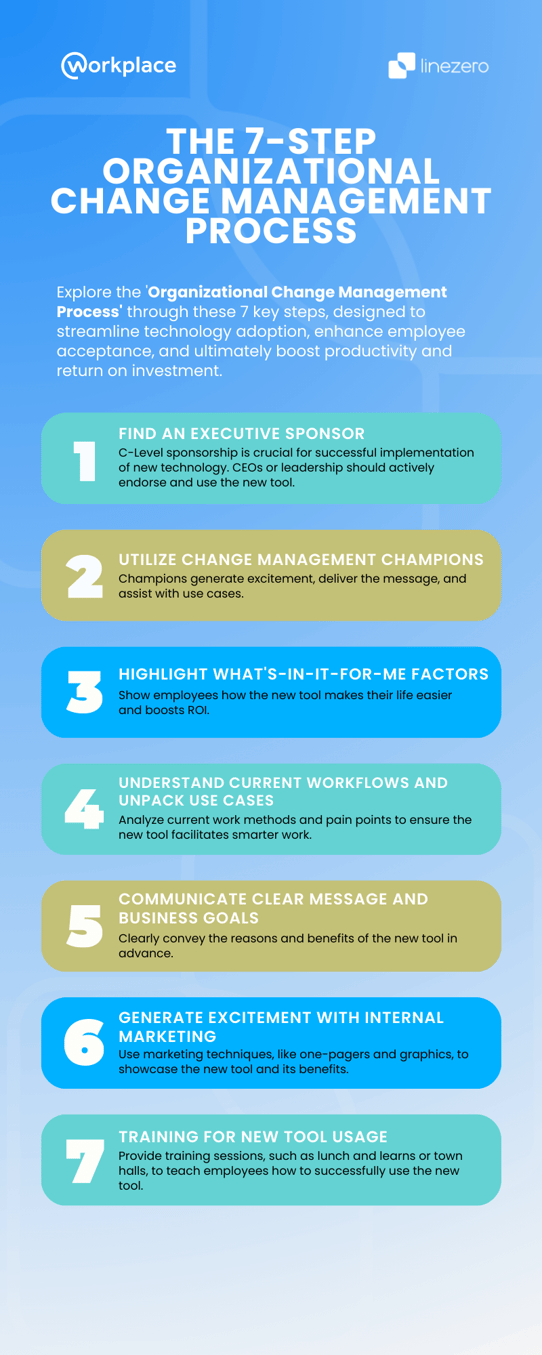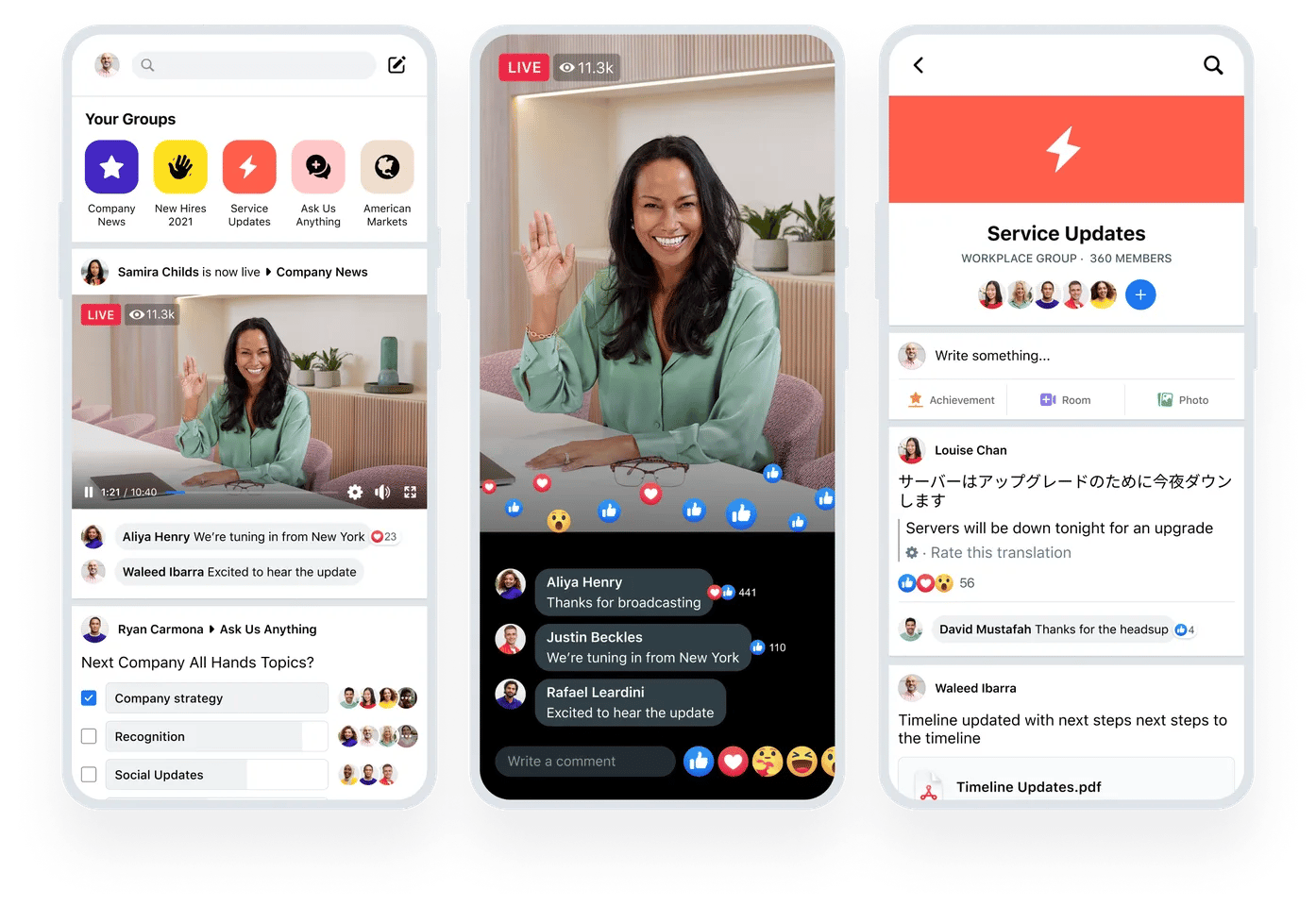In today's dynamic business landscape, organizational change management is indispensable. As businesses evolve and industries transform, the way we manage organizational changes becomes crucial for success. From introducing a new Software-as-a-Solution (SaaS) to fostering a culture of continuous innovation, understanding the organizational change management process is essential.
But what is organizational change management? How has it evolved over the years? Why is it important, especially in the realm of business change management? And how can modern tools, such as Workplace from Meta, enhance our change management in the workplace?
In this blog, we'll dive deep into these questions, guiding you through:
🏢 Organizational Change Management: Where We've Come From
📋 The Organizational Change Management Process – 7 Key Steps to Follow
🔧 Importance of Change Management Tools
🔄 Organizational change management: Where We Are Now
💻 Why Software-as-a-Solution is Beneficial
🌐 Workplace from Meta can Enhance Change Management
Join us as we explore the nuances of managing organizational change, offering insights, strategies, and practical solutions to drive your business forward in this ever-evolving digital era.

Technology has advanced significantly in the past decade, and while that change has been all for the better in some aspects, other aspects, like organizational change management, have suffered greatly. So, in this blog, we’re going to look at organizational change management from back then and compare it to the journey now, examining the evolution of change management while also showing you why proper change management is so important and how tools like Workplace from Meta can aid your change management in the digital age.
Let’s dive right in.
What is Organizational Change Management (OCM)?
Organizational Change Management (OCM) refers to the process of planning, implementing, and managing changes within an organization to ensure smooth transitions, minimize resistance, and maximize the desired outcomes. It involves the systematic approach of managing the human side of organizational change to support successful adoption and adaptation by individuals, teams, and the organization as a whole.
the Organizational change management process - 7 key steps to follow
In order to get the most out of your investment and aid in a smoother transition to the new technology you’re implementing, let’s look at seven key steps that we think your organizational change management process should be following:
1. Find an executive sponsor
Research shows that sponsorship from the top (C-Level) down is the most important success factor in implementing a new technology or tool. If you want to make your employees feel better about the change, have your CEO or the leadership team champion this initiative and actually use the new technology or tool.
2. Use champions to deliver the message, generate excitement and help with use cases
Just like Jane in our example above, change management champions can help your employees to get excited about what the changes to the organization will mean for them.
3. Identify the what's-in-it-for-me factors
Employees, as mentioned, need to understand what the new technology or tool is going to do for them. When you take the time to show them how this is going to make their life easier, they’re much more likely to embrace the new technology and, in turn, increase their ROI.
4. Understand how the employees currently work and unpack the use cases for the new technology or tool
Before you implement something new, understand how your employees are currently doing their jobs, and determine what pain points they’re experiencing. This, along with the previous step, will help you to ensure that you’re implementing something that’s going to make them work smarter, not harder.
5. Communicate a clear message, highlight the business goals, and again the benefits
Let your employees know why you’re implementing this new technology or tool in a clear, concise way (and make sure that you’re doing this well before the implementation!).6. Generate excitement using internal marketing technique
Show people the new tool or technology in action, create one-pagers and graphics that will help employees understand the benefits of the new technology or tool, and let people know when they can expect changes to take place. Internal marketing techniques like these will help you get everyone on the same page long before the new tool or technology is implemented.
7. Training: Make sure your employees know exactly what to do with the technology or tool
Host training, lunch and learns, or town hall meetings where you walk through the new tool and give your employees the proper training that they need to be successful in using it.

Organizational Change Management: Where We've Come From
Before the Software-as-a-Solution (SaaS) era, getting a new tool was a lengthy process that took months, if not years, to implement. It was an ordeal but also an instructive change management case study.
It was a huge undertaking! Deciding to buy the tool, determining how you were going to roll it out, satisfying various hardware and software requirements, purchasing the proper equipment, implementing it in your organization then, testing and fixing bugs, investing in end-user training, and then finally rolling the new tool out to everyone – what an ordeal!
But there was a huge benefit to this amount of hassle to implement something. Since it was such a high price tag to get exactly what they wanted, organizations took much longer and were much more deliberate in planning out their long-term goals and objectives regarding this new tool they were purchasing.
Importance of change Management Tools
In today's rapidly evolving business landscape, the tools that facilitate change management are invaluable. Consider Jane's scenario, which mirrors many real-world challenges. When Jane spots a last-minute vacation deal but can't immediately verify her leave balance, she loses the opportunity. This lack of real-time information signals a broader issue—inefficient operational systems.
The CFO, recognizing the inefficiency, suggests implementing a company-wide intranet system, encompassing tools like HR modules for leave balance checks, collaborative platforms, and internal communication tools. Notable examples include Workplace from Meta, Slack, and Microsoft Teams, which enhance transparency and real-time communication.
With the buzz of the new intranet system, employees like Jane become ambassadors of change. This positive reception can be attributed to the effective utilization of another change management tool: timely communication. By rolling out the intranet after ample communication and preparation, the company sets a precedent on the crucial role of change management tools for successful transformation.

Organizational change management: where we are now
The digital revolution has ushered in a new era of organizational change management. Integrating Software-as-a-Solution and Cloud-based technologies means that today's tools are plug-and-play. These platforms, while quicker to deploy, still require strategic integration into the business's ecosystem. They have shifted the emphasis from technical readiness to user adaptability. With tools that can be instantly activated, the onus now lies on ensuring employees are aligned, informed, and prepared for these changes.
Why Software-as-a-Solution is Beneficial
In many ways, SaaS options provide your organization with a number of key benefits. For instance, monthly subscriptions provide organizations with easy payment options with no huge upfront costs required, and SaaS products allow organizations easy access to a number of great tools that will help them make work easier and get things done faster.
However, the ease of implementation does have one massive disadvantage: it doesn’t require the same amount of planning. This means that having an organizational change management plan is even more important now than it ever used to be. Not only to prepare your employees for the change that’s about to take place but also to plan out exactly which tools you’re going to implement and how they’re going to work together within your environment. Plus, some of these tools are quite similar – if you were to implement a tool in your organization that does something similar to another tool that you already have, do your employees know when to use what?
-1.png?width=1045&height=661&name=MicrosoftTeams-image%20(15)-1.png)
By introducing new tools (and even new features within a previously established tool), organizations often overlook the change management process and how this change will affect their end users.
There is an assumption that because it’s easier for organizations to implement, it’ll be easier for employees to adapt to it, but that’s not the case. Without properly preparing your end users, you’re forcing them into “resistance mode” – they haven’t been told how this new tool or new feature is going to make their lives easier, they see it as more of a hassle than anything else, and they don’t want to take the time to learn something new.
Conclusion
In this rapidly evolving digital era, effective organizational change management is more crucial than ever. The successful implementation of any new technology or tool is significantly amplified when an organization adopts a strategic, systematic approach. This involves sponsorship from leadership, employee engagement, clear communication, and thorough training. These key steps will help organizations leverage the full potential of their investments and foster a smoother transition to new tools or technologies.
Workplace from meta can ENHANCE CHANGE MANAGEMENT
Here at LineZero, our focus on organizational change management is paramount. Our approach to integrating Workplace by Meta (Workplace) within organizations is holistic, ensuring optimal returns on investment. This spans initial planning, personalized communication, comprehensive training, and post-launch support.

Workplace stands out with its multifaceted capabilities and high user acceptance, providing a powerful platform to boost productivity, enhance collaboration, and foster rapid innovation. It serves as a catalyst to enrich employee engagement and nurture a strong community while consolidating your knowledge management needs on a single, easy-to-navigate platform.
As a highly secure and customizable platform, Workplace seamlessly integrates with a wide range of enterprise software and file-sharing applications. Its cross-platform compatibility ensures it is readily accessible from any device. Its robust conversation and file search capabilities ensure the required content is always at your fingertips. Ultimately, the Workplace paves the way for an efficient, collaborative, and thriving work environment, significantly easing the journey of organizational change.
Are you ready to embrace digital transformation but worried about change management?
At LineZero, we facilitate seamless integration of Workplace by Meta, empowering organizations to streamline operations and foster collaboration.
Take the first step towards a more productive, collaborative, and engaged workplace today
Connect With Us' to start your Workplace from Meta journey.
Tags:
Corporate CultureOctober 25, 2023




Comments